With a sweet and creamy taste and tender yet textured mouthfeel, scallops are one of the finest foods ever harvested from the sea. They’re also easy to cook well, especially if you know all of the facts and secrets of purchasing and cooking.
Like a little underwater jet, the scallop adductor muscle pumps water to feed and swim. In many countries the entire scallop (sans shell) are eaten, in the US we generally just eat the main muscle.
Types of Scallops
Scallops are the adductor muscle of bi-valves, which squeezes the shells together to jet propel them through the water. There are three types of scallops eaten in the USA: Sea, Bay and Calico.
Sea Scallops are relatively large and ideal for pan searing or grilling.
Bay Scallops are smaller and harvested in shallower bays rather than the deep ocean, wonderfully sweet, they are ideal for stir fries, risotto and in pasta dishes. Most frozen bay scallops are farm raised in China and treated with chemicals, not recommended. We most commonly stock Diver Bay Scallops from the Sea of Cortez, in season (hand caught in nets by divers).
Calico Scallops are a smaller size, but they don’t have the premium taste of sea and bay scallops. We don’t normally stock these, but we’ll gladly special order them for you.
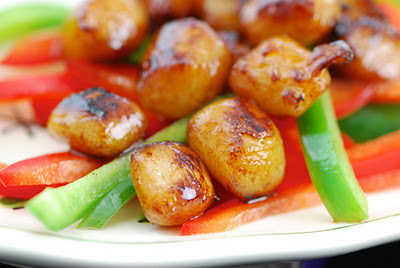 |
| Teriyaki Seared Diver Bay Scallops |
Other Scallop Terms
Day Boat Scallops: Many boats go out for several days at a time to harvest scallops in deeper waters, but Day Boat Scallops come from boats that only go out one day at a time, making them the fresher option. We always buy Day Boat Scallops at Tony’s.
Diver Scallops: This is not a type of scallop; rather it’s a sustainable harvesting method where divers scoop them up with nets.
Wet Scallops: ‘Wet’ scallops are treated with STP (Sodium Tripolyphosphate) a chemical
preservative that also acts to soak up copious amounts of water, increasing scallop
weight and size considerably. Unfortunately all this added water means they scallops just don’t cook right and truly pale in comparison to dry scallopsIf you see scallops that are overly white and plump with a mild scent and a lot of milky liquid in the pan, they’re most likely treated with STP. Frozen scallops are also commonly treated with STP, look at the label to see what chemicals have been added. “Scallop product water added” or “X% Water Added Scallop Product” must be added to the label of scallops with more than 80% water content – but they aren’t always sold in packages. STP is a terribly common seafood additive that we work hard to avoid.
Dry Scallops: Untreated scallops in their natural state and the only scallops to consider in
my opinion. They cook and taste much better, but do have a stronger scent right from the shell.
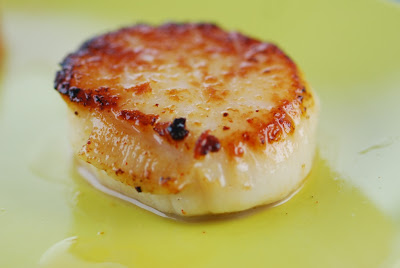 |
| Sea scallop pan seared in my Taste of Tokyo Rub. |
Characteristics
Color: Quality sea scallops range from a creamy beige to light blond color. Some females can have an orange to pink hue, which does not affect taste (and they turn white when cooked). Bay scallops are generally lighter and whiter. Avoid bright white sea scallops, a sign of treating with STP.
Odor: Fresh scallops do have a stronger odor than other seafood, but it dissipates when cooked. Treated scallops have a much milder odor thanks to the preservative and added water
Sizes: Sea scallops are packed by count, with the largest scallops costing the most. A designation of “20/30 Count” means there are between 20 and 30 per pound. U/10 is the largest size, meaning there are less than 10 per pound. Bay Scallops are commonly from 40 to 90 per pound, but they’re sometimes smaller.
Nutrition: Scallops are a lean and healthy – a 3.5 oz. serving of untreated sea scallops has about 88 calories, 0.8 g fat and 17 grams of protein. Bay scallops offer about 80 calories, 0.6 g fat and 15 G of protein.
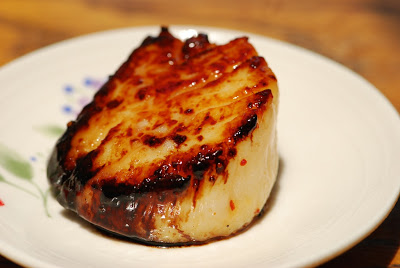 |
| Sea scallop marinated in teriyaki and pan seared. |
Cooking Scallops
Sea Scallops: Big and thick, they’re perfect for pan searing or grilling. They cook very quickly and are at their best with a nice brown crust and a lightly cooked interior. Don’t be fooled, even though they are thick, they are very lean so they cook quickly and can toughen if overcooked.
For searing, start a large, heavy skillet (the bigger and heavier the better, more metal holds more heat for better browning – on the grill, a heavy cooking grate works much better than wire grates). Preheat pan or grill with medium high heat to about 400°. Season or marinate scallops
as desired. Add a drizzle of oil and when very hot, sear 1-3 minutes per side.
Bay Scallops: Too small to sear consistently, so they’re better quickly stir-fried over very high heat, or simmered in pasta sauces. A sweet marinade, such as teriyaki sauce, helps them brown much more quickly. Total cooking time is usually 1-5 minutes depending on conditions.
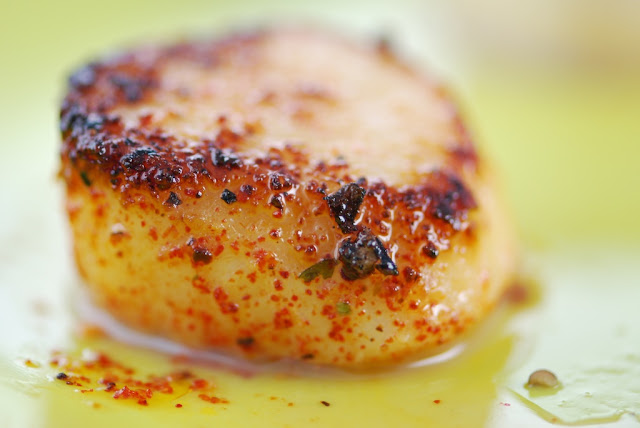 |
| Sea scallop pan seared in my Chile Arriba! Seasoning Rub |
Recipes:
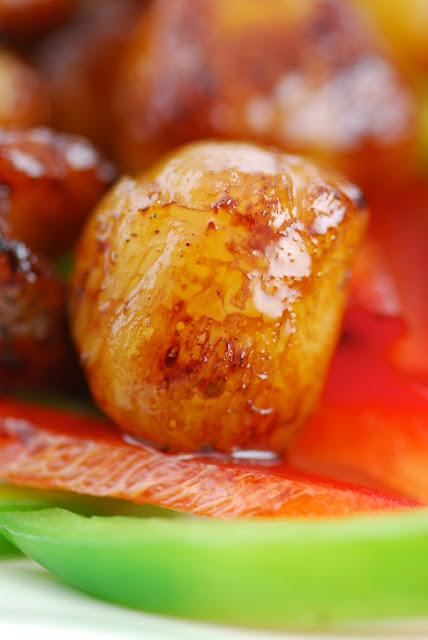 |
| Seared Teriyaki Diver Bay Scallop |
Scallop Tattinger
Breaded scallops in the shell with shallots, mushroom and garlic. I prepared this recipe live on the Channel 7 News for Pierre Tattinger (of Champagne Tattinge, Riems, France).
Quick Teriyaki Scallop Stir-Fry
Seared Jumbo Scallops with Saffron Risotto
Bay Scallop Ceviche
If using larger sea scallops, slice or cut into smaller pieces.
Seared Teriyaki Scallops
Great with either bay or sea scallops
Seared Scallops with Hollandaise
Risotto with Wild Mushrooms and Scallops
Comments are closed.

